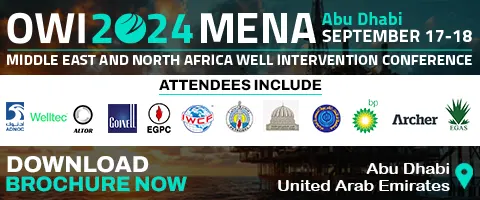In The Spotlight
Aramco is ahead of the curve in spearheading cutting-edge technology such as artificial intelligence (AI), both in its own operations and beyond, according to new research from GlobalData

The World Bank forecasts that oil prices could go above US$100/bl if the Middle East crisis escalates. (Image source: Adobe Stock)
A major flare-up in Middle-East conflict could stoke global inflation and drive oil prices above US$100/bbl, according to the World Bank’s latest Commodity Markets Outlook

Berri gas plant is the first facility in the Master Gas System in Jubail Industrial City, and was inaugurated in 1977. (Image source: Aramco)
Baker Hughes has won an order to supply compressors for the third phase of Saudi Arabia’s Master Gas System project
-

Rockwell Automation interview with Sebastien Grau
-

Rockwell Automation interview with Michael Sweet
-

ADIPEC 2023 - Exclusive interview with Wissam Chehabi, Fishbones
-

Rockwell Automation interview with Kalypso’s Rodrigo Alves and Knowledge Lens’ Ganesh Iyer
-

ADIPEC 2023 - Exclusive interview with Feby Mohammed, Belden

Berri gas plant is the first facility in the Master Gas System in Jubail Industrial City, and was inaugurated in 1977. (Image source: Aramco)
Baker Hughes has won an order to supply compressors for the third phase of Saudi Arabia’s Master Gas System project
ADNOC has signed a 15-year LNG agreement with Germany’s EnBW Energie Baden-Württemberg AG (EnBW), for the delivery of 0.6 million metric tonnes per annum (mmtpa) of LNG
Honeywell has launched a new process to improve the efficiency and sustainability of light olefin production
The naphtha to ethane and propane (NEP) technology generates a tunable amount of ethane and propane from naphtha and/or LPG feedstocks, generating more high-value ethylene and propylene with reduced production of lower-value by-products compared to a traditional mixed-feed steam cracking unit and resulting in net cash margin increases. An NEP-based olefins complex also reduces CO2 intensity per metric ton of light olefins produced by 5 to 50% versus a traditional mixed-feed steam cracker.
More efficient production
“The petrochemical industry faces strong competition and challenges in obtaining raw materials globally,” said Matt Spalding, vice president and general manager of Honeywell Energy and Sustainability Solutions in MENA. “Our technology helps to enable more efficient production of ethylene and propylene, two chemicals which are in high demand, while also helping our customers lower their carbon emissions.”
The new solution is a part of Honeywell’s Integrated Olefin Suite technology portfolio to enhance the production of light olefins.
Halliburton has introduced SentinelCem Pro cement system to help customers address losses while drilling
SentinelCem Pro cement simplifies mixing operations by eliminating the need for pre-hydration of the slurry design and access to high-purity water sources. This feature facilitates more efficient rig operations with the option to direct mix the system on-the-fly or in a batch mixer. The single-sack packaging facilitates storage in offshore and remote locations.
The thixotropic nature of SentinelCem Pro cement allows the system to stay fluid while pumped into lost-circulation zones and to rapidly gel when pumping stops. This feature enables the system to penetrate deep into fractures and vugular formations to mitigate costly drilling fluid loss to the formation. The system’s early compressive strength development enables a quick return to drilling operations.
Portfolio addition
The SentinelCem Pro system is an addition to Halliburton’s lost circulation portfolio, which addresses a wide range of lost circulation issues. Lost circulation is commonly encountered in drilling and cementing operations and can be a costly challenge to overcome.
“Lost circulation is the main contributor to costly nonproductive time (NPT) in well construction,” said Matt Lang, vice president of Cementing, Halliburton. “SentinelCem Pro cement safely pumps through the bottom-hole-assembly to help customers quickly address lost circulation events and reduce NPT."
More than 175 people, including senior representatives of the region's leading oil and gas companies, attended a very topical and engaging live webinar hosted by Oil Review Middle East entitled “Beyond Boundaries: Advanced Surveillance for Oil and Gas Remote Facilities”
Thomas Evans, Origination Lead EMEA at global professional services company GHD discusses the prospects for scaling up hydrogen development in the MENA region
How do you view prospects for advancing hydrogen development in the region, and what role will the UAE's National Hydrogen strategy play in advancing hydrogen development in the UAE?
The prospects for advancing hydrogen development in the region are extremely promising. Particularly in the Middle East, countries not only have access to abundant natural resources but also possess significant investment capabilities and expertise in attracting international businesses and talent. Combined with economic stability, the region is well positioned as a global leader in low-carbon hydrogen production and innovation.
Developed in alignment with the UAE’s Centennial 2071 ambition, the UAE's National Hydrogen Strategy provides a comprehensive roadmap for establishing a successful hydrogen economy. A key focus of the strategy is on generating and supporting a domestic hydrogen market. While there may be a temptation to concentrate on production capabilities, understanding and developing domestic demand is crucial. The strategy recognises that although the technology for hydrogen export is still evolving, successful and economically sustainable hydrogen economies should first focus on their domestic markets, with the potential for international exports in the mid to long term.
The UAE's strategy also stresses the need for the integration of various hydrogen production technologies. It considers the use of blue hydrogen (derived from natural gas with carbon capture, utilisation, and storage (CCUS)), green hydrogen (produced from renewable sources), and other emerging technologies to meet its ambitious targets. A diverse technological approach will be key to advancing hydrogen development.
What are the main challenges to scaling up hydrogen development, and how can these be tackled?
Scaling up hydrogen development presents several challenges, particularly when examining the context of the UAE’s hydrogen industry.
Most importantly, there is a need for clear governance and regulatory frameworks to facilitate the growth of the hydrogen economy. We can draw valuable lessons from international examples such as the US Inflation Reduction Act, the UK Hydrogen Business Model, and EU policies like Fit for 55 and the European Hydrogen Bank. Establishing such frameworks will help remove barriers and provide more investment opportunities, propelling the hydrogen strategy forward.
The CAPEX and OPEX for low-carbon hydrogen production are currently high. Without effective market mechanisms, hydrogen is unable to compete on price with natural gas and other fossil fuels. Addressing this challenge requires the implementation of policies and incentives that can lower costs and make hydrogen more competitive. Having said this, we have seen CAPEX prices decreasing in the last 2 years by around 25% to 30% which is a positive sign for the industry.
The low-carbon hydrogen offtake market is still immature. In the UAE, there is a significant opportunity to become a leader in domestic hydrogen usage and the production of high-value green products for both export and domestic markets, such as green steel. However, there is a degree of "progress paralysis" globally, due to uncertainties about the growth rate of the hydrogen offtake market. Developing a robust domestic demand is crucial in the short term, as it helps de-risk investments by providing a guaranteed market for hydrogen products.
Supply chain constraints represent both an opportunity and a challenge for the UAE’s hydrogen economy. Currently, the global supply chain is under pressure, with long lead times and slower than anticipated technology learning rates. Strengthening the local supply chain can alleviate these issues.
Read the full interview in the latest issue of the magazine, at https://oilreviewmiddleeast.com/magazines/orme_2024_05_02/spread/?page=18




























































